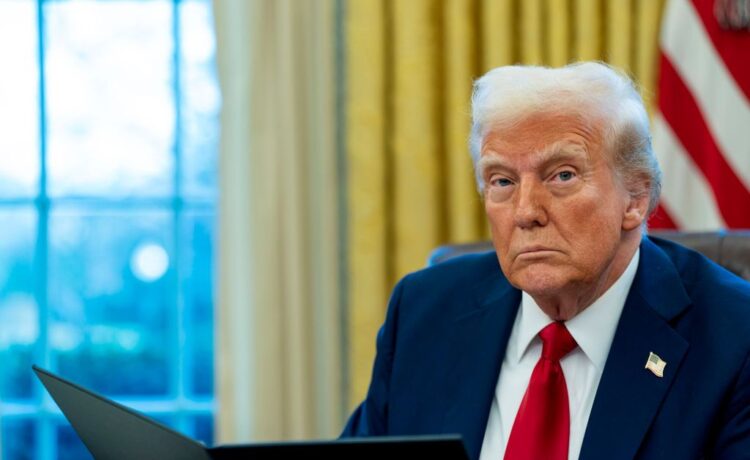Refresh
Trump pauses tariffs on Mexico for one month
US tariffs on Mexico have been paused for one month following a conversation between Trump and Mexican president Claudia Sheinbaum.
Sheinbaum wrote on social media site X: “We had a good conversation with president Trump… we reached a series of agreements”.
Mexico has agreed to reinforce its northern border with 10,000 National Guards to reduce drug trafficking. In return, Sheinbaum has sought commitment from the United States that it will prevent the trafficking of high-powered weapons to Mexico.
How much revenue will tariffs raise for the US government?
On social media, Trump has previously said that revenue from tariffs could be used to pay off US debt and “make America wealthy again”. However, it is US consumers who will end up footing at least part of the bill in the form of more expensive goods.
“Revenues from the tariffs could reach almost $250bn per year, or 0.8% of GDP. That could be a significant hit to the US economy if those revenues are used to reduce the federal budget deficit rather than recycling them into the economy by cutting taxes or boosting federal spending,” said Paul Ashworth, chief North American economist at Capital Economics.
He adds that US exporters will also lose out thanks to a stronger dollar. They could also be hit by retaliatory measures from other countries.
US equity markets fall
The S&P 500, the Dow Jones Industrial Average and the Nasdaq are all in the red this morning.
At the time of writing, around 30 minutes after market open:
- S&P 500: -1.77%
- Dow Jones: -1.38%
- Nasdaq: -2.24%
“Trump’s launch of tariffs in 2018 did raise revenues for America but US corporate profits took a hit that year and America’s S&P 500 index fell by a fifth, so markets have understandably taken fright this time around,” said Russ Mould, investment director at AJ Bell.
China to challenge tariffs at World Trade Organisation
China’s Ministry of Commerce has said it will take “corresponding countermeasures” against the US after Trump announced a 10% tariff on Chinese imports. It has not yet given any specifics.
China has also threatened to take a complaint to the World Trade Organisation (WTO), although experts say there is little the WTO will be able to do.
First and foremost, the US has previously ignored WTO rulings under the Biden administration. Furthermore, the body within the WTO that is responsible for resolving disputes is currently short on judges, as the US has been blocking new appointments for the past two years. This means the judges can no longer achieve a quorum.
Retaliatory tariffs: Canada bites back
“Canada will not stand by as the United States imposes unjustified and unreasonable tariffs on Canadian goods,” the Canadian government said. “In response, we are moving forward with 25% tariffs on $155 billion worth of imported US products.”
Some items (covering $30 billion of US imports) will be impacted from 4 February, including certain foods, beverages, cosmetics and more.
Other items (covering the remaining $125 billion) will be hit at a later date, including things like passenger vehicles, steel and aluminium.
Markets were not prepared for Trump’s aggression
Trump has surprised markets over the weekend with both his speed and aggression.
George Saravelos, global head of FX research at Deutsche Bank, says: “By our estimates, the market was roughly pricing the equivalent of a 5% universal tariff being enacted in coming months, equivalent to a 30bps ‘hump’ in the US inflation curve.
“The announcements this weekend are roughly three times larger with reasonable passthrough assumptions, i.e., we would expect a 1% US headline inflation impact if tariffs are sustained.
“These tariffs are also roughly five times as large as the cumulative sum of trade actions taken under the first Trump administration measured in terms of average tariff increases.”
Saravelos thinks the market needs to “structurally and significantly reprice the trade war risk premium”.
What do tariffs mean for inflation?
Just as prices were coming under control, Trump’s tariffs could fan the embers of inflation on a global scale.
Firstly, US consumers will need to pay more for imports from impacted countries.
US businesses will feel the effects too, if they have imported goods or materials anywhere in their supply chain.
If costs increase, businesses could be forced to raise their prices in an attempt to protect their margins – another hit for consumers.
Furthermore, the countries that Trump has targeted are already starting to respond with retaliatory tariffs of their own, and so the problem spreads.
The effects won’t be confined to the US, Canada, Mexico and China either. Global economies operate in a tangled web of interdependence. If goods in the US suddenly become more expensive to produce because of tariffs, any other country that imports those goods will have to pay a premium too.
Carve-out for Canadian energy
Trump’s tariffs include a special carve-out for Canadian energy imports, which will be hit with a lower 10% tariff (as opposed to 25%).
According to the BBC, 61% of oil imported into the US between January and November last year came from Canada.
Canadian prime minister Justin Trudeau has previously said that Canadian energy “powers American manufacturing, businesses and homes.”
Speaking in recent weeks before Trump’s tariffs were imposed, Trudeau added: “The alternative for [the US] would be more resources from Russia, China or Venezuela. Canada is a safe, secure and reliable partner in an uncertain world.”
Over the weekend, Trudeau announced 25% retaliatory tariffs against the US in response to the latest developments.
Canada and Mexico: is a recession on the cards?
“Since exports to the US account for around 20% of their GDP, today’s tariffs could plunge both the Canadian and Mexican economies into recession later this year,” said consultancy Capital Economics.
The effect of Trump’s tariffs will be felt in the US too, though, with consumers now facing the prospect of higher prices. Capital Economics expects US inflation to rise further and faster than previously anticipated, exceeding 3% later this year.
European tariffs: “the writing is on the wall”
Although no tariffs have been directed at Europe so far, the “writing is on the wall”, according to Michael Field, chief market strategist at Morningstar. “That Donald Trump has no qualms about imposing them on his nearest neighbours, means that Europe too should be bracing for impact,” he added.
Trump recently told the BBC that the European Union has “taken advantage” of the US and is “way out of line” for not importing more US goods. In 2023 (the most recent year we have annual figures for), the US-EU trade deficit was $208.2 billion.
“They don’t take our cars, they don’t take our farm products, they take almost nothing. And we take everything from them,” Trump said.
Markets tumble as trade war heats up
Stock markets tumbled in Asia on Monday in response to the latest news from Washington. In Taiwan, the Taiex index shed 3.53%. In Japan, the Nikkei 225 closed 2.66% lower. Meanwhile, in South Korea, the Kospi fell 2.52%.
European markets have also tumbled so far this morning, as investors process the fact that the EU could be next on Trump’s hit list. The Stroxx Europe 600 is down more than 1% at the time of writing.
Meanwhile in the UK, the FTSE 100 is down more than 1% so far. Trump has indicated that a deal could be “worked out” with the UK to exclude it from tariffs, but even if this is the case, a global trade war would spell bad news for domestic markets and the economy.
This is not a drill
On 1 February, US president Donald Trump announced 25% tariffs on Canada and Mexico and a 10% tariff on China, due to kick in from 4 February. The trade wars have begun.
Trump made extensive tariff threats while on the campaign trail in the lead-up to the US election but, until recently, experts had been warming up to the idea that these were little more than a bargaining chip. The latest moves suggest otherwise.
Here’s everything you need to know – from what’s been announced to how markets have responded.












